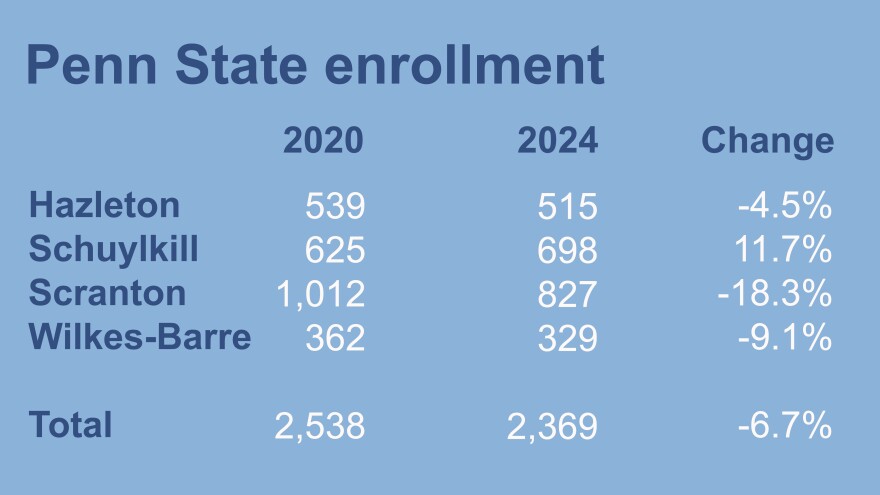More than 2,300 students attend one of four regional campuses of Penn State University. After the 2026-27 academic year, some of those campuses may close.
Amid declining enrollment and great financial pressures, university President Neeli Bendapudi announced on Tuesday that the school can no longer afford to keep all 19 Commonwealth campuses open.
“Across higher education, institutions are grappling with similar headwinds, and we have reached a moment where doing nothing is no longer an option,” Bendapudi said in her letter.
The seven largest campuses — Abington, Altoona, Behrend, Berks, Brandywine, Harrisburg and Lehigh Valley — will remain open. The future of the 12 remaining campuses, including Hazleton, Schuylkill, Scranton and Wilkes-Barre, will be decided by a university committee. The university plans to announce the final plan before the end of the spring semester.

Enrollment at the Commonwealth campuses has declined by about 24% over the last decade. In the last five years at the four campuses in the Northeast, enrollment declined by a combined 6.7%. The Schuylkill campus, located in Schuylkill Haven, is the only regional campus to see enrollment increase. With 329 students, the Wilkes-Barre campus, located in Lehman Twp., is the second smallest campus in the state system. Shenango, in Mercer County, is the smallest.
Tuesday’s news was met with disappointment, worry — and even a bit of hope at Penn State Scranton.
Gavan Quimby is optimistic about the future of Penn State Scranton, located in Dunmore. The president of the Student Government Association pointed to the recent upgrades at the campus, including the library and the nursing suite.

"There's a lot of hope between students," he said.
He said Penn State’s land-grant mission ensures that a four-year degree is within reach for individuals from all backgrounds. Closing a campus in the Northeast puts that four-year Penn State degree out of reach for many potential and current students.
He said the small campus and small class sizes gave him the chance to get to know his professors on a personal level. His friends who attend University Park don't often know much about their teachers other than their name.
"Each professor has the time to get to know you and get to know your life and your personality and what you like ... it's a different feeling," he said.
Bob Durkin, president of the Greater Scranton Chamber of Commerce, said that each of the campuses in the Northeast seems to have its own signature program. For example, Scranton has engineering and Hazleton has computer science.

“We don't want to lose any of the academic strengths these institutions bring,” he said. “If we find ourselves facing closures specifically here, I hope that Penn State can do an effective job of consolidating the academic experiences for the students and keep all of that here in Northeastern Pennsylvania.”
Durkin, who also serves on the Scranton campus’ advisory board, said he’s not surprised that the decisions must be made.
“The financial circumstances being what they are, there's no question that they had to deal with this in a draconian way,” he said.
Marc Wyandt, superintendent of the Lakeland School District, also serves on the advisory board for Penn State Scranton.
“It would be a shame to lose Penn State Scranton,” he said. “It is a school that provides tremendous opportunities to area students. It does so at an affordable rate.”
Many of the students who receive those opportunities are students from underserved populations, including those who are the first in their families to attend college.
“Losing Penn State Scranton would be a significant loss to our area,” he said.

Justin Dorneman graduated from Penn State in May 2024. He spent his four years at the Scranton campus, despite originally planning to attend his last two years of college at University Park. Penn State had been his dream school since the third grade.
"It meant a lot for me to be able to go there and to get a Penn State education while being able to stay home for four years, spending more time with my family, with my friends, while still getting essentially the same, if not in a lot of aspects, a better education than I would have gotten had I went to University Park," he said.
He said the campus gave small school vibes while having the resources of a Big 10 school. There's also the financial aspect to the university's regional campuses.
"I saved thousands, if not tens of thousands of dollars on room, board, etc., that I would have spent easily if I went down to University Park," he said. "So I think it was a huge benefit being able to do all four years at Scranton."





